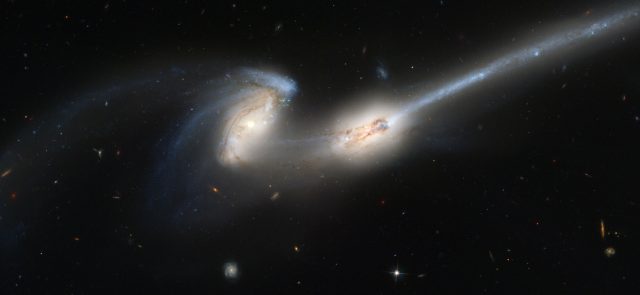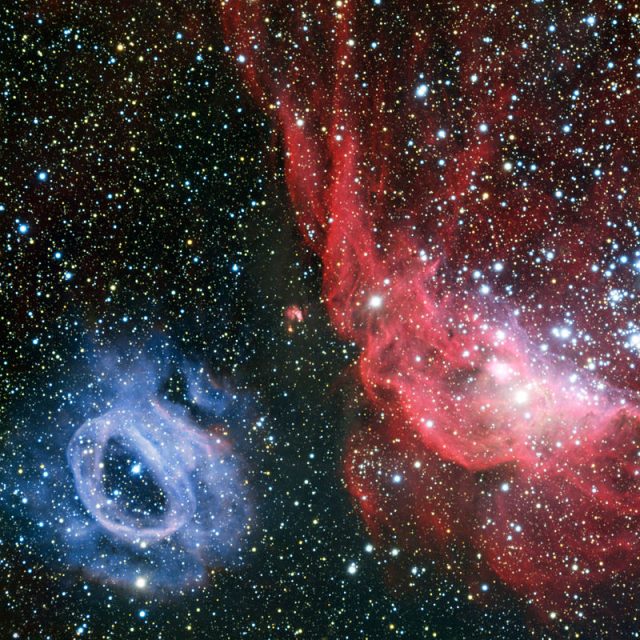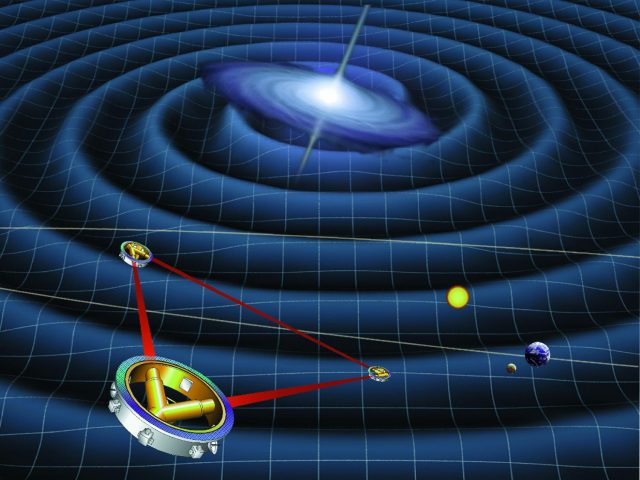The dark collapse of merging galaxies as the origin of supermassive black holes

I remember very well my physics professor during my first year at university. She stressed the importance of having clear intuitions of what physical terms mean before any mathematics was invoked. ‘Imagine someone drops an 100-gram apple 1 metre above your head’, she would say; ‘the pain you feel is the equivalent of a joule of potential energy’; the scream you let out when you receive the hit could be seen as the potential energy of the apple before dropping transformed into radiation energy. We may find that this strange way of looking at ordinary things is useful when talking about how black holes are created.
A black hole is an object in space that has collapsed under its own gravitational forces to such an extent that the minimum speed needed to escape from the gravitational field, the so-called escape velocity, is the speed of light. Actually, the event horizon of a black hole is the region of space where escape velocity reaches the speed of light. This implies that not even light can escape from inside the event horizon and, therefore, the object is absolutely black in all the frequencies of the electromagnetic spectrum. Hence, we can not get to know anything of what happens inside by direct observation.
Black holes can have different sizes, depending on how and from what they came to existence. Their mass is measured using the mass of the Sun as an unit. Thus, stellar black holes may be 10 times the mass of the Sun. But these are small. Intermediate ones have a mass range that starts at 1,000 solar masses, that figure is 1,000,000 for supermassive black holes and could reach 10,000,000,000 – yes, 10 billion times the mass of the Sun. We can understand, more or less, the creation of a black hole from the collapse of a huge star but how is it possible that such a thing as a supermassive black hole comes to exist?
Lucio Mayer, from the University of Zurich and Kavli Institute of Theoretical physics, and Ikerbasque research fellow Silvia Bonoli (DIPC), have reviewed 1 what we know so far, and they have come to some interesting conclusions investigating an alternative approach, the merger of galaxies.
The first evidence on the existence of supermassive black holes comes from the discovery of quasars and radio galaxies in the 60s. When X-ray satellites became available, many of these sources revealed also powerful X-ray emission. Galaxies presenting this kind of activity are generically referred to as active galactic nuclei (AGN), as the activity originates from the nuclear region of the galaxy itself.
Now is when the apple becomes useful. It was soon realized that the most natural way to explain the gargantuan luminosities associated with such astrophysical phenomena, which can outshine the galaxies that host them, is the energy radiation derived from the loss of potential energy of matter as it falls onto a massive compact object located in the galactic nucleus. This accretion process, which is driven purely by the gravitational pull of the compact nuclear object, is known to be the most efficient way to convert a mass reservoir into heat, and then radiation.
The combination of dynamical analysis for the study of ‘dormant’ black holes, and the study of the frequency of AGN, led to the conclusion that massive black holes are ubiquitous at the centre of galaxies over a broad range of masses, from the most massive early-type galaxies at the centres of groups and clusters to the relatively low-mass galaxies the size of the Large Magellanic Cloud.

Many models have been proposed for the origin of massive black holes, where the different formation scenarios postulate different types of precursors (or ‘seeds’) for the massive black holes. After formation, seed black holes start experiencing phases of exponential growth, which generally wash away direct information on the initial mass. The initial mass of the seeds depends on the type of precursor and on the processes associated to the formation of the black hole.
The most straightforward, and widely explored, scenario assumes that the precursors of black hole seeds are the first generation of stars, appearing in the first hundred million years of the history of the Universe. Despite the large masses reached by these stars (100–1,000 solar masses), the seed black holes resulting by the collapse of such stars would be orders of magnitude below the mass of supermassive black holes.
Alternative theories have explored models in which seeds form from the collapse of very large gas clouds, with a significantly larger initial mass (bigger than 10,000 solar masses). Depending on the type of evolution of the precursor gas cloud, the upper limit for the seed mass could range from 1 million to 1 billion solar masses in some very extreme scenarios. These models, commonly referred to as ‘direct collapse’ or ‘heavy seed’ models, have gained more popularity in the recent years, as more evidence is building up on the existence of extremely massive black holes at very high redshifts (1), and such heavy seeds provide a significant ‘head start’ for the mass build-up of the black holes powering the most luminous quasars.
However, one important constraint on formation scenarios comes from the existence of very bright quasars (2), which are already present at redshifts as high as z = 7.1, i.e., only 500 million years after Big Bang. It is a problem how to explain that such large masses as those of supermassive black holes can be achieved so early on.
In 2010, Lucio Mayer and his collaborators began considering a whole different scenario for the emergence of direct collapse seeds. This model relies on a particular trigger of multi-scale inflows: galaxy mergers. In this alternative picture the event generating the conditions for black hole seed formation in the galactic nucleus is the major merger between two massive gas-rich galaxies.
Now, the researchers investigate the merger driven model with simulations of binary mergers between massive gas-rich disks, with a structure similar to present-day spiral galaxies. Star forming galaxies with stellar masses comparable to the ones of massive spirals, such as our own Milky Way at the present day, already exist at z = 10.

They find that that supermassive, gravitationally bound compact gaseous disks weighing a billion solar masses, quite compact in size, form in the nuclei of merger remnants in less than 100,000 years. These could later produce a supermassive protostar or supermassive star at their centre via various mechanisms.
The researchers argue that merger-driven scenario lends itself naturally to one particular, intriguing route called dark collapse. In this case a massive black hole would emerge from direct dynamical collapse of the core, with no intermediate stage. Perhaps the only aftermath in this case will be gravitational waves, hence the term dark collapse.

Laser Interferometer Space Antenna (LISA), an approved ESA mission whose mandate is to detect gravitational waves from space, will provide the only direct way to probe the particular dark collapse idea, since ultra-massive seeds forming in this way will emit a gravitational wave signal during their asymmetric collapse, which can be calculated and is expected to fall in the low frequency band and above the sensitivity curve of the current instrument design.
Notes:
- Redshift (z) is the way astrophysicists refer to distance in spacetime, the bigger the number, more far away and older, closer to the Big Bang, the object is. This dimensionless number is related to the Doppler effect and Hubble’s law.
- Quasars, quasistellar objects, are believed to be nuclei of galaxies in which there is a violent activity, so powerful that the object appears pointlike. It has been proposed that the power source is a supermassive black hole accreting material from the stars and gas in the surrounding galaxy.
Author: César Tomé López is a science writer and the editor of Mapping Ignorance
References
- Lucio Mayer & Silvia Bonoli (2018) The route to massive black hole formation via merger-driven direct collapse: a review Reports on Progress in Physics doi: 10.1088/1361-6633/aad6a5 ↩
1 comment
I can’t wait until the Webb telescope launches and reaches L2 to see what your research reveals.